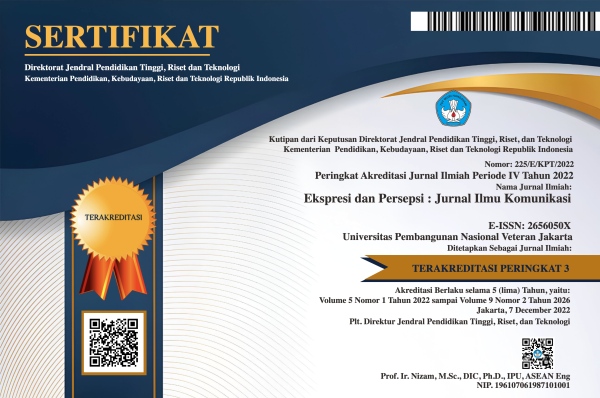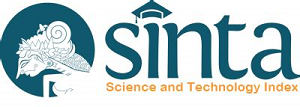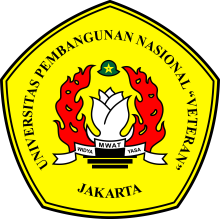REDUCING PUBLIC SKEPTICISM THROUGH CSR COMMUNICATION
DOI:
https://doi.org/10.33822/jep.v6i3.6494Keywords:
controversial industry, CSR communication, public skepticismAbstract
This study aims to analyze Corporate Social Responsibility communication as an effort to reduce public skepticism towards PT HM Sampoerna, this is based on the pros and cons of the CSR program and CSR communication especially in controversial industries such as cigarette companies. Using four dimensions of CSR initiative messages, namely CSR Commitment, CSR impact, CSR Motive and CSR FIT with a qualitative content analysis method, the primary data of this study are posts on the official social media account @insidesampoerna during the data collection period from 1 January 2023 to 30 May 2023 Based on the results of the coding, the researcher found that most of the company's CSR communications used the message of the CSR Impact initiative which was represented by the description "the impact that has been felt by stakeholders. Furthermore, CSR motivation, CSR Commitment and CSR Fit can also be seen in the company's Instagram posts.
References
Arli, D., Rundle-Thiele, S., & Lasmono, H. (2015). Consumers’ evaluation toward tobacco companies: Implications for social marketing. Marketing Intelligence & Planning, 33(3), 276–291. https://doi.org/10.1108/MIP-01-2014-0015
Chitra Dinisari, M. (2020). Sampoerna Raih Penghargaan The Most Tax-Friendly Corporate. https://kabar24.bisnis.com/read/20201216/79/1331746/sampoerna-raih-penghargaan-the-most-tax-friendly-corporate
De Jong, M. D. T., & Van Der Meer, M. (2017). How Does It Fit? Exploring the Congruence Between Organizations and Their Corporate Social Responsibility (CSR) Activities. Journal of Business Ethics, 143(1), 71–83. https://doi.org/10.1007/s10551-015-2782-2
Dedeoğlu, B. B., Taheri, B., Okumus, F., & Gannon, M. (2020). Understanding the importance that consumers attach to social media sharing (ISMS): Scale development and validation. Tourism Management, 76, 103954. https://doi.org/10.1016/j.tourman.2019.103954
Du, S., Bhattacharya, C. B., & Sen, S. (2010). Maximizing Business Returns to Corporate Social Responsibility (CSR): The Role of CSR Communication. International Journal of Management Reviews, 12(1), 8–19. https://doi.org/10.1111/j.1468-2370.2009.00276.x
Dunn, K., & Harness, D. (2019). Whose voice is heard? The influence of user-generated versus company-generated content on consumer scepticism towards CSR. Journal of Marketing Management, 35(9–10), 886–915. https://doi.org/10.1080/0267257X.2019.1605401
Foreh, M. R., & Grier, S. (2003). When Is Honesty the Best Policy? The Effect of Stated Company Intent on Consumer Skepticism. Journal of Consumer Psychology, 13(3), 349–356. https://doi.org/10.1207/S15327663JCP1303_15
Ham, C.-D., & Kim, J. (2020). The effects of CSR communication in corporate crises: Examining the role of dispositional and situational CSR skepticism in context. Public Relations Review, 46(2), 101792. https://doi.org/10.1016/j.pubrev.2019.05.013
Harizan, S. H., & Hamid, F. S. (2015). Corporate Social Responsibility of Tobacco Companies: A Consumer Perspective. Asia Pacific Institute of Advanced Research (APIAR)
Hirschhorn, N. (2004). Corporate social responsibility and the tobacco industry: Hope or hype? Tobacco Control, 13(4), 447–453. https://doi.org/10.1136/tc.2003.006676
Joireman, J., Liu, R. L., & Kareklas, I. (2018). Images paired with concrete claims improve skeptical consumers’ responses to advertising promoting a firm’s good deeds. Journal of Marketing Communications, 24(1), 83–102. https://doi.org/10.1080/13527266.2015.1126757
Kent, M. L., & Taylor, M. (2016). From Homo Economicus to Homo dialogicus: Rethinking social media use in CSR communication. Public Relations Review, 42(1), 60–67. https://doi.org/10.1016/j.pubrev.2015.11.003
Kompas, C. (2018). Sampoerna Raih 3 Penghargaan di Ajang CSR Global Award 2018. 2018. https://biz.kompas.com/read/2018/05/13/234632928/sampoerna-raih-3-penghargaan-di-ajang-csr-global-award-2018
Kurniawan, I. (2019). HM Sampoerna Raih Global CSR Awards 2019. https://www.neraca.co.id/article/115678/hm-sampoerna-raih-global-csr-awards-2019
Lee, T. H., & Comello, M. L. (Nori) G. (2019). Transparency and Industry Stigmatization in Strategic CSR Communication. Management Communication Quarterly, 33(1), 68–85. https://doi.org/10.1177/0893318918807566
Lee, Y.-J., O’Donnell, N. H., & Hust, S. J. T. (2019). Interaction Effects of System-Generated Information and Consumer Skepticism: An Evaluation of Issue Support Behavior in CSR Twitter Campaigns. Journal of Interactive Advertising, 19(1), 15–28. https://doi.org/10.1080/15252019.2018.1507853
Lee, Y.-J., Yoon, H. J., & O’Donnell, N. H. (2018). The effects of information cues on perceived legitimacy of companies that promote corporate social responsibility initiatives on social networking sites. Journal of Business Research, 83, 202–214. https://doi.org/10.1016/j.jbusres.2017.09.039
Lesmana, Sandi A., & Muflih, F. F. (2021). Gara-gara Seruan Larang Pajang Iklan Rokok, Anies Terancam Digugat ke Pengadilan. 2021. https://www.suara.com/news/2021/10/01/205750/gara-gara-seruan-larang-pajang-iklan-rokok-anies-terancam-digugat-ke-pengadilan
Lii, Y.-S., & Lee, M. (2012). Doing Right Leads to Doing Well: When the Type of CSR and Reputation Interact to Affect Consumer Evaluations of the Firm. Journal of Business Ethics, 105(1), 69–81. https://doi.org/10.1007/s10551-011-0948-0
Maulida, R. A., Uljanatunnisa, U., & Sevilla, V. (2021). Pengaruh Pemberitaan Tuduhan Eksploitasi Anak Terhadap Citra PT Djarum Indonesia. Ekspresi & Persepsi: Jurnal Ilmu Komunikasi (4) 2. 213-223. https://doi.org/10.33822/jep.v4i2.2801
Moreno, F., & Kang, J. (2020). How to alleviate consumer skepticism concerning corporate responsibility: The role of content and delivery in CSR communications. Corporate Social Responsibility and Environmental Management, 27(6), 2477–2490. https://doi.org/10.1002/csr.1969
Purwanti, T. (2021). HM Sampoerna Raih The Best Community Impact. https://www.cnbcindonesia.com/market/20211130200145-17-295652/hm-sampoerna-raih-the-best-community-impact
Rim, H., & Kim, S. (2016). Dimensions of corporate social responsibility (CSR) skepticism and their impacts on public evaluations toward CSR. Journal of Public Relations Research, 28(5–6), 248–267. https://doi.org/10.1080/1062726X.2016.1261702
Sheilanabila, S. A. (2021). Pro-Kontra: Display Rokok di Minimarket DKI Ditutup, Setuju Nggak? Detikhealth.Com. https://health.detik.com/berita-detikhealth/d-5723677/pro-kontra-display-rokok-di-minimarket-dki-ditutup-setuju-nggak
Skarmeas, D., & Leonidou, C. N. (2013). When consumers doubt, Watch out! The role of CSR skepticism. Journal of Business Research, 66(10), 1831–1838. https://doi.org/10.1016/j.jbusres.2013.02.004
Skarmeas, D., Leonidou, C. N., & Saridakis, C. (2014). Examining the role of CSR skepticism using fuzzy-set qualitative comparative analysis. Journal of Business Research, 67(9), 1796–1805. https://doi.org/10.1016/j.jbusres.2013.12.010
Song, B., & Wen, J. (Taylor). (2020). Online corporate social responsibility communication strategies and stakeholder engagements: A comparison of controversial versus noncontroversial industries. Corporate Social Responsibility and Environmental Management, 27(2), 881–896. https://doi.org/10.1002/csr.1852
Supriyatna, I. (2022). HM Sampoerna Raih BISRA Award 2022 untuk CSR dan Pengelolaan Bencana. 2022. https://www.suara.com/bisnis/2022/07/13/074750/hm-sampoerna-raih-bisra-award-2022-untuk-csr-dan-pengelolaan-bencana
Tandilittin, H., & Luetge, C. (2015). CSR activity of tobacco companies in Indonesia: Is it a genuine social responsibility? Online Journal of Health Ethics, 11. https://doi.org/10.18785/ojhe.1101.03
Tölkes, C. (2018). Sustainability communication in tourism – A literature review. Tourism Management Perspectives, 27, 10–21. https://doi.org/10.1016/j.tmp.2018.04.002
van Rekom, J., Go, F. M., & Calter, D. M. (2014). Communicating a company’s positive impact on society—Can plausible explanations secure authenticity? Journal of Business Research, 67(9), 1831–1838. https://doi.org/10.1016/j.jbusres.2013.12.006
Velarosdella, N. R. (2021). Langkah Anies soal Kampanye Anti-rokok di Jakarta, Kirim Surat ke Bloomberg hingga Larang Pajang Bungkus Rokok. Kompas.Com. https://megapolitan.kompas.com/read/2021/10/05/15135781/langkah-anies-soal-kampanye-anti-rokok-di-jakarta-kirim-surat-ke
Yasmine, S. M., & Swara, V. Y. (2022). Understanding the Practices of Strategic CSR in Controversial Industry: Case of Tobacco Company in Indonesia. Jurnal Pemberdayaan Masyarakat: Media Pemikiran Dan Dakwah Pembangunan, 6(1), 69–90. https://doi.org/10.14421/jpm.2022.061-04
Downloads
Published
Issue
Section
License
Copyright (c) 2023 Uljanatunnisa Uljanatunnisa, Febriany, Della Bagus Nur

This work is licensed under a Creative Commons Attribution-NonCommercial 4.0 International License.














